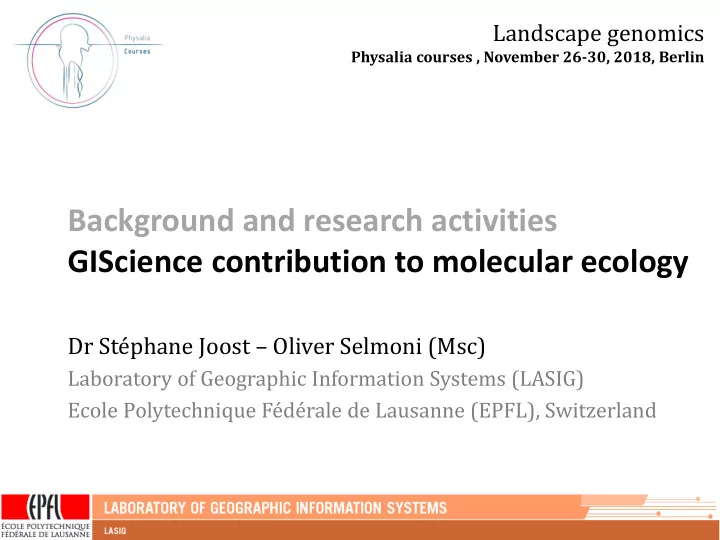

Landscape genomics Physalia courses , November 26-30, 2018, Berlin Background and research activities GIScience contribution to molecular ecology Dr Stéphane Joost – Oliver Selmoni (Msc) Laboratory of Geographic Information Systems (LASIG) Ecole Polytechnique Fédérale de Lausanne (EPFL), Switzerland
GIS Lab @ EPFL • School of architecture, civil and environmental engineering (ENAC) • Institute of Environmental engineering (IIE) • Laboratory of Geographic Information Systems (LASIG) • Research group – Landscape genetics and spatial epidemiology – Analysis of the relationship between living organisms and their environment. – Use of GIS and spatial statistics for the analysis and management of health data and genetic resources
Who we are • Stéphane Joost – Geology, geography and computer science at University of Lausanne (Switzerland) – University of Geneva, MicroGIS Inc., EPFL (PhD), UCSC Piacenza (Italy) • Oliver Selmoni – MSc in Biology, University of Lausanne, Switzerland – PhD student at EPFL, seascape genomics
Genetic information is GEO • In its natural framework, genetic information is embedded within a geographic context • Plants, animals, humans are directly influenced by the characteristics of their surrounding environment • thus the spatial dimension of genetic information has to be considered when trying to understand genetic resources • We address this perspective from a GIScience angle
Biology or geography ?
GIS and biology at EPFL • 2001, FP5 ECONOGENE project • Conservation of small ruminant genetic resources in Europe
Interdisciplinary project • Interdisciplinary approach with biologists, veterinarians, economists, GIScientists, sociologists • Brought together by Régis Caloz, Godfrey Hewitt and Pierre Taberlet, Mike Bruford • Project chaired by Paolo Ajmone-Marsan • Alessio Valentini Two roles for GIS…
1. Data integration • Integration of different types of information produced by a variety of disciplines • Multicriteria decision- making support for the definition of con- servation priorities between endangered breeds
2. Spatial analysis of genetic data • Test and assess the potential contribution of spatial analysis to extract information and new knowledge in molecular ecology • Support basic research on natural selection and adaptation processes, and on evolution in general
Main current projects • EU H2020 IMAGE: Innovative Management of Animal Genetic Resources (improve genomic methodologies, biotechnologies, and bioinformatics) • SNSF GENESCALE: at which scale does natural selection operate? multiscale landscape genomic (Arabis alpina) • EU FP7 NEXTGEN: adaptation in sheep, goats, cattle, whole genome data, Iran, Morocco, Uganda • ADCORE: seascape genomics • URBANGENE: multispecies investigation of the impact of the urbanization process on genetic diversity in the Geneva cross-border area
Original contribution of GIScience • URBANGENE (http://urbangene.epfl.ch)
Effects of urbanization on genetic diversity
But where are the ponds ? ? ? ? ? ? ? ? ? ? ? ?
Urbangene.heig-vd.ch
Add a pond…
Recommend
More recommend